Creation and annihilation phenomena of electron and positron pairs in an oscillating field*
M Jiang(江淼) D D Su(苏丹丹) N S Lin(林南省) and Y J Li(李英骏)
1School of Science,China University of Mining and Technology,Beijing 100083,China
2State Key Laboratory for Geomechanics and Deep Underground Engineering,China University of Mining and Technology,Beijing 100083,China
3Beijing National Laboratory for Condensed Matter Physics,Institute of Physics,Chinese Academy of Sciences,Beijing 100190,China
Keywords: pair creation,computational quantum field theory,strong laser field
1. Introduction
One of the most fascinating subjects in high energy physics is that the vacuum can be polarized under an external strong field, which is predicted by the theory of quantum electrodynamics. In 1951,Schwinger calculated the threshold of the“breakdown”vacuum under an ultra-strong static electric field,[1]which attracts a number of experts to study pairs creation under different external fields.[2-12]The critical value of the vacuum polarization for a time-independent and spatially homogeneous electric field isEc=1.32×1016V/cm,which requires a laser beam with the tremendous intensity about 1029W/cm2. Under the present experimental condition, it cannot be achieved to observe the particle pairs creation phenomenon directly from the vacuum only due to the effect of light. However, recent research has come into view using the extremely high-power laser field due to the continued advancement of the laser-based system. With the rapid development of the laser technique, it is believed that in the near future,the intensity of the laser will be able to approach or even reach the Schwinger limitation.
The particle pairs can be created from vacuum due to three mechanisms. The first mechanism is called the Schwinger tunnelling effect.[13-15]It requires a static electric field that exceedsEc= 1.32×1016V/cm and the particlepairs can be created persistently from the vacuum under this ultra-strong external electric field. The second mechanism indicates that the electron-positron pairs can also be created permanently when the external electric field changes rapidly over time,which is known as the photon transition effect.[16-18]For the third mechanism,to generate particle pairs,the supercritical quasi-bound state caused by a supercritical potential well is required.[19-24]To further understand the pair creation process,more sophisticated field configurations are applied,which requires the combination of the above fields. Some studies combined a static strong field with an oscillating field,such a combination will induce the dynamically assisted Schwinger effect,which has been wildly discussed recently.[16,25-27]
2. Quantum field theoretical simulations
In order to describe the pair creation process, in this paper we apply the numerical solution of the Dirac equation on whole time and space scale by applying the quantum field theory.[28,29]We consider a one-dimensional system,in which the evolution of the field operator ˆΨ(z,t)can be expanded in terms of creation and annihilation operators and positive and negative energy states

The subscriptspandnin this equation represent positive and negative energy, respectively. Hereup(z) andvn(z) are the initial positive and negative states that can be obtained by solving the force-free Dirac equation,while ˆbpand ˆd†ndenote the annihilation and creation operators for positive or negative state,respectively.
To obtain the spatial density and total number of created electrons,the electronic portion of the field operator associated with positive energy can be defined as

The spatial density of created electron is defined as

where||vac〉〉denotes the vacuum state. Using the two equivalent expressions for the time evolution of the field operator ˆΨ(z,t) in Eq. (1) and the initial state property ˆbp||vac〉〉=0,after some algebra the spatial density can be obtained as follows:

The total number of the created particles can be obtained by integratingρ(z,t) over space. In Eq. (4),φn(z,t) is the state function for negative states. The evolution of the state function follows the Dirac equation(in atomic units hereafter)

Herecis the speed of light in vacuum(c=137.036 a.u.),αzdenotes thezcomponent of the Dirac matrix,andβis the diagonal Dirac matrix. The time-dependent scalar potential associated with the external force acting along thezdirection is presented byV(z,t).
The Dirac equation can be solved numerically using the split-operator method,[30,31]while the time evolution operator e-ihtis decomposed into multiple consecutive actions, each subinterval operators can be approximated by e-ihΔt ≃e-iVΔt/2×e-ih0Δt×e-iVΔt/2,whileh0is the forcefree Hamiltonian and the error is of orderO(Δt3). Using the Fourier transformation between the spatial and momentum representation, we can compute the action of the corresponding propagators.
3. The creation and annihilation phenomena of particles
In this paper, the one-dimensional model is considered under a combination of scalar potentialV(z) =V1S(z)sin(ωt)+V2S(z), which consists of an oscillating electric field and a static electric field, whileS(z) ={1+tanh[(z-z0)/W]}/2 is the Sauter potential.[32]The center of the field is located atz0with a width ofW. The intensity of the oscillating electric field and static electric field areV1andV2,respectively,while the frequency of the oscillating field isω.
In this model,the oscillating field and the static field plays different parts during the pair creation process.The oscillating field with a high frequency will create particles continuously,while the created particles will occupy the energy states and block further particle creation due to the Pauli Blocking effect for a fermionic system. The static field is added to clean out the interaction region thus increase the number of created particles. The previous result shows that,while only the oscillating field is applied,both the momentum and the spatial density distribution of the created particles are symmetrical.[25]With the additional static field,the symmetric distribution would be broken and the created particles can be dragged out of the interaction region. However, with a symmetrical distribution,while half of the created particles are accelerated and moving out of the interaction region,the other half would be decelerated and dragged back into the interaction area,thus affect the creation process afterwards.
To analyze these effects,we first obtain the time evolution of the total number of created particles. In Fig. 1, the intensity of the oscillating field is set asV1=c2and the frequency isω=2.5c2,which gives a time cyclete=2π/ω=1.34×10-4.Due to the photon transition effect, for a frequency that is larger than the energy gap 2c2, particles can be created continuously. Though the total simulation timet=0.002, to focus on the effect of the dragged-back particles,we present the time evolution of the created number fromt=0.0015 to 0.002,which gives a better expression of the details. Here we choose four different intensities of the external static fieldV2= 0,0.2c2,0.5c2,0.8c2,which are shown in Figs.1(a),1(b), 1(c),and 1(d),respectively. We can see that with different intensities of the external static fields, the number of created particles all grows linearly over time,with minor oscillations alone the curves that shape repetitively for each cyclete, which is marked with dashed lines in Fig.1. However,with increasing the intensity of the static field,the curves for each cycle shape differently.
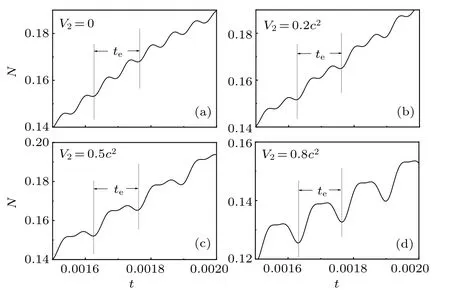
Fig. 1. Time evolution of the total number of created particles under different intensities of the external static field. The amplitude and frequency of the external oscillation field are V1 =c2 and ω =2.5c2, the width of both fields is W =3/c.
In the absence of the static field forV2=0 as shown in Fig. 1(a), the oscillating period in time corresponds tote/2,and the time evolutions of the created number in the first half cycle and the second half cycle are identical. This is due to the fact that,if we only apply the oscillating field,the energy of the single-photon will be sufficient to cross the energy gap,then the potential function of the first half period and the last half period will be equivalent.ForV2=0.2c2in Fig.1(b),such a symmetry would be broken by the static field so the shape of the minor oscillation is slightly different from that forV2=0 because the intensity of the static field is relatively small. ForV2=0.5c2in Fig. 1(c), the shapes of the first half cycle and the second half cycle are obviously different,while in the beginning stage of the first half cycle the increase of the created number is more obvious, and in the last stage of the second half cycle the created number decreases faster. In Fig.1(d)for a intensityV2=0.8c2,both the increase in the first half cycle and the decrease in the second half cycle become steeper, as observed from the curve.
For each period, with differentV2, the creation process behaves differently. For the first half cycle 2n×te/2<t <(2n+1)×te/2, the slope of the curves is always positive regardless of the intensity of the static fieldV2, and increase faster for stronger field intensity. However, with the increase of the intensity for the static field, in the second half cycle(2n+1)×te/2<t <(2n+2)×te/2 the slopes of the curves gradual reduces and even changes from positive to negative.The slope of curves can be considered as the creation rate of the particles. For a positive creation rate, the system is experiencing a creation phenomenon,while for a negative creation rate,it is considered as an annihilation phenomenon.
The reason is that the created particles(here only consider one kind of particles such as electron or positron) are able to escape from the interaction region to both the left and right directions with the absence of the external static fieldV2(as shown in Fig. 2(a)). However, by adding the external static field(the direction can be assumed as pointing to the left),the left-moving positrons would be accelerated and pushed out of the field region while the right-moving particles are decelerated. For the left-moving accelerated positrons in Fig.2(b),a stronger static field will evacuate more particles thus increase the total number as shown in the first half cycle in Fig.1,due to the Pauli blocking principle for a fermionic system. On the other hand, while the static field is strong enough, the rightdecelerated-moving particles will be dragged back to the interaction region as presented by Fig.2(c),and annihilate with the created electrons. Thus,an annihilation phenomenon will appear on the curve as a negative slope, as observed in the second half cycle in Fig.1. Otherwise,it would be a creation phenomenon if the decelerated particles can not be dragged back to interaction region and keep moving to the right while the static field is relatively weak.

Fig.2. The different motion modes for the created positrons. (a)Only the oscillating field is applied,which is indicated by an up arrow,and e+ are the created positrons which head to two directions in one-dimensional simulation. (b) and (c) The created positrons experience three motion modes by adding the static electric potential,which is presented by the solid curve.
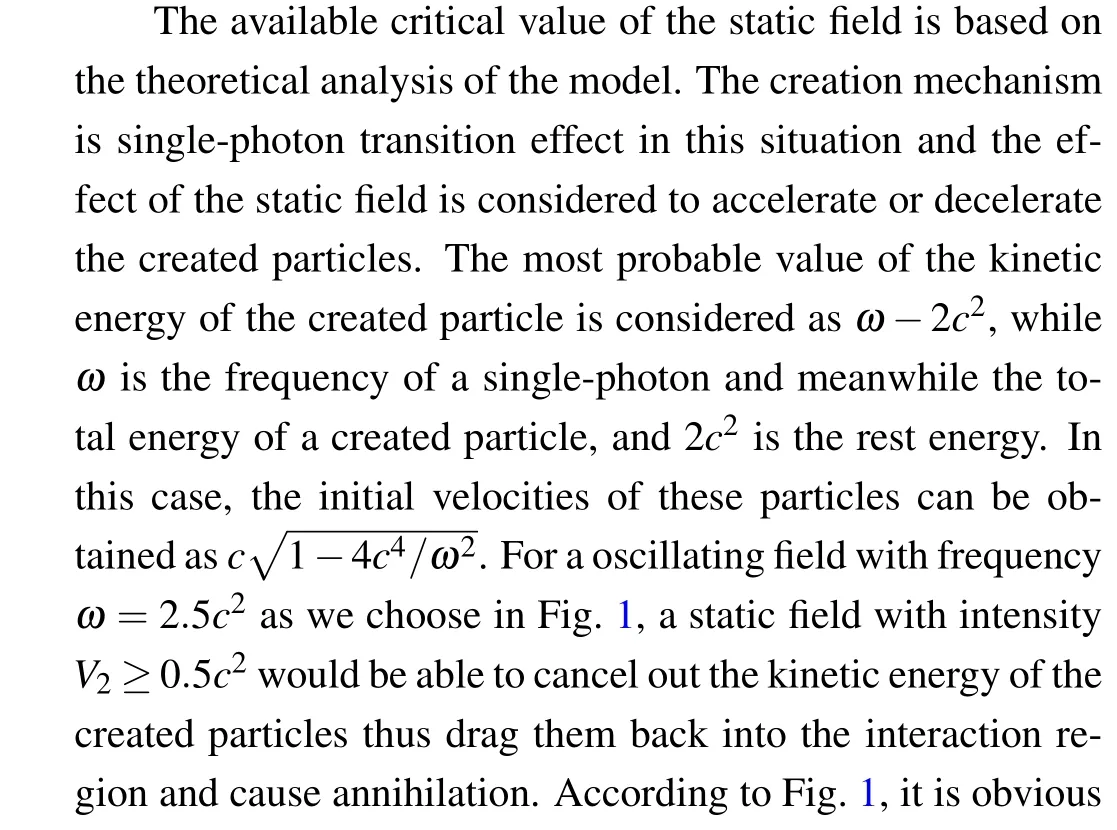

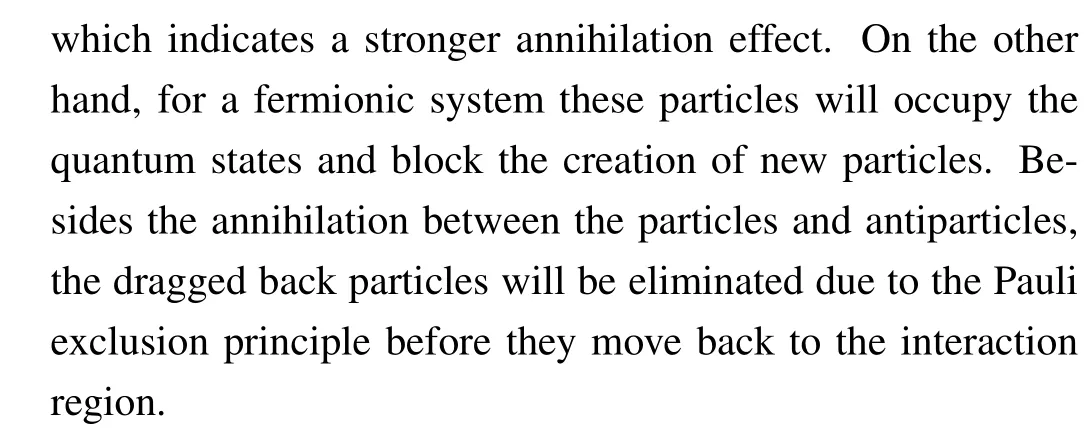
To analyze the effect of different field width on the creation rate,we define the equivalent creation rate asη=Γ/W,whileΓis the creation rate of the particles andWis the width of the oscillating field. For a smaller field widthW,a narrower range of the energy distribution for the created particles can be obtained. Therefore, the energy of the created particles will be more concentrated on the most probable energyω-2c2,[33]and more created particles will be dragged back when the intensity of the external static field exceeds the critical valueV2=0.5c2. Figure 3 presents the time evolutions of the created particles for different field widths with the same oscillation intensity and frequency, compared to Fig.1,when the static field intensityV2=0.8c2. As shown in Fig. 3, the slopes of the curves in the second half cycle(2n+1)×te/2<t <(2n+2)×te/2 decrease with the increase of the field widthW. The slopes indicate the creation rates of different field widthsW=2/c,W=3/c,W=4/candW=5/c,which areΓa=-158.9,Γb=-109.8,Γc=-146.3 andΓd=-34.0, respectively. The equivalent creation rates of these widths areηa=-79.45,ηb=-36,6,ηc=-11.6 andηd=-6.8. For small field widthW,more particles with concentrated energy will be dragged back and cause the annihilation phenomenon, thus the negative slope will be steeper.With the increase of the field width,the energy distribution of the created particles becomes wider and less particles will be dragged back, the annihilation effect will be weaker and the absolute value of the negative slope decreases.
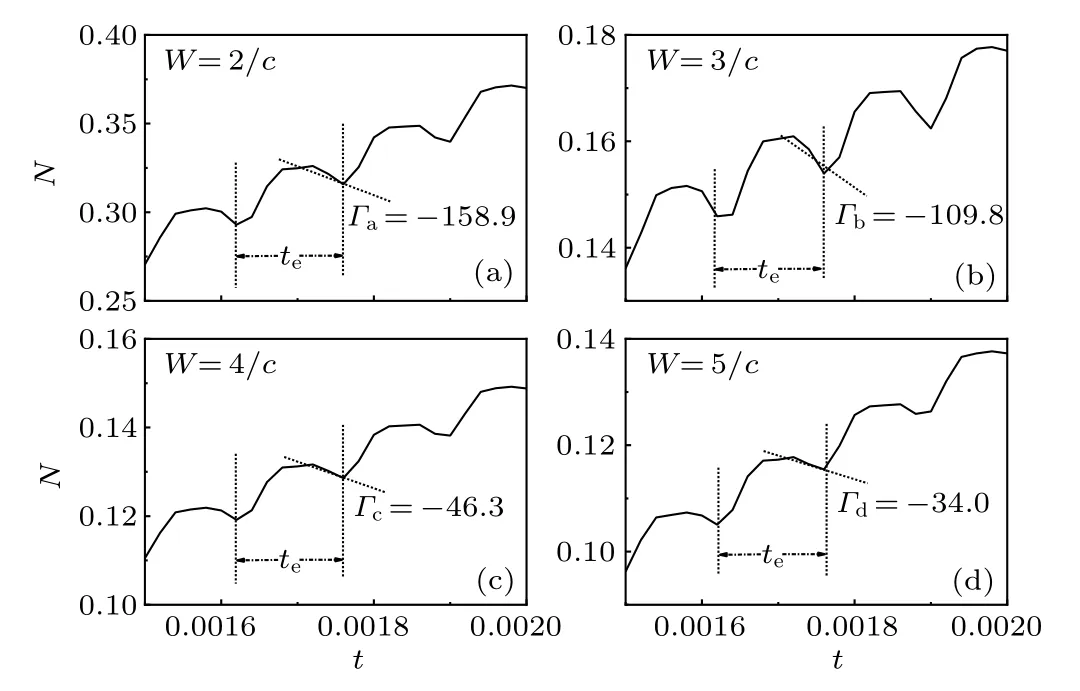
Fig.3. Time evolution of the total number of the created particles under different widths of the external static electric field. The amplitude and frequency of the oscillating field is V1=c2 and ω=2.5c2,the intensity of the external static electric field is V2=0.8c2.
4. The spatial density and momentum distribution of the created particles
To observe the annihilation phenomena in space and the effect of the static field on the trajectory of the created particles, here we focus on the spatial density distributions of the created particles under different intensities of the external static fieldV2att=0.002.
In Fig.4,the picture show the simulated results of the created electrons,while the positrons moves toward the opposite direction. Here we set same parameters as Fig.1. The dotted curve is the spatial density whileV2=0, which is symmetric aboutz0=-0.3,because there exist two directions of the initial velocities for the created particles in an one-dimensional model, and the created particles cannot be accelerated or decelerated while the external static field intensity is absent. The created particles will move out from the center of the interaction region with a constant velocity to both sides,thus results in a symmetric distribution. It is worth mentioning that,due to the Pauli exclusion principle,the creation of new particles will be blocked for a fermionic system,and should be promoted if the created particles are pulled out of the interaction region.

Fig. 4. The spatial density distribution of the created electrons under different intensities of the external static field V2 at t=0.002. The amplitude and frequency of the oscillating field is V1=c2 and ω =2.5c2,when the field widths is W =3/c. The center of the fields is located at z0=-0.3.
It is observed that for the dashed curve, which are simulated with a static field intensityV2=0.2c2, the created particles exists in-0.3<z <0 and-0.6<z <-0.3 regions att=0.002. Under such a static field,half the created particles which move to the right direction are accelerated, and other particles which move to the left direction are decelerated. For a static field with intensityV2=0.2c2that is less than the critical intensityV2=0.5c2as we estimated in Section 3, due to the asymmetric distribution of the external field, the spatial density distribution is no longer symmetric. In the left region for-0.6<z <-0.3 the created electrons are pushed towards the right direction, compared with that forV2=0(the dotted line),and in the right region for-0.3<z <0 a small amount of annihilation effect can be observed. This is because, even for a static field with a weak intensityV2=0.2c2,a small portion of the created particles with slow initial velocities will be dragged back into the interaction region and affect the creation process. ForV2=0.5c2more particles can be dragged back,the curve becomes more asymmetric as presented by the dotdashed line, and the created electrons are mainly ejected into the region-0.3<z <0. For an even stronger static field with intensityV2=0.8c2, the created electrons mainly exist in the region-0.3<z <0,which indicates that most of the created electrons moving toward left are dragged back to the interaction region and annihilate with the antiparticles, and a more obvious annihilation effect can be observed in the right region
-0.3<z <0.
Compare the four different curves, we can find that the created electrons that distribute in the left region for-0.6<z <-0.3 decrease gradually with the increasing intensity of the external static fieldV2, and more and more decelerated particles can be dragged back to the interaction region. However, some electrons with high initial kinetic energy still can escape from the interaction region so there also exist a small portion of electrons even for a strong static field with intensityV2=0.8c2. In the right region for-0.3<z <0,with the increase of the intensity of the static field,the annihilation effect becomes more and more obvious,which is in accordance with the time evolution curve of the total number of the created particles as shown in Fig. 1. It is also worth mentioning that for the electrons that with initial velocities heading toward the right direction,they will be accelerated in the presence of the static field and pushed out of the interaction region directly,thus have no effect on the following creation process.
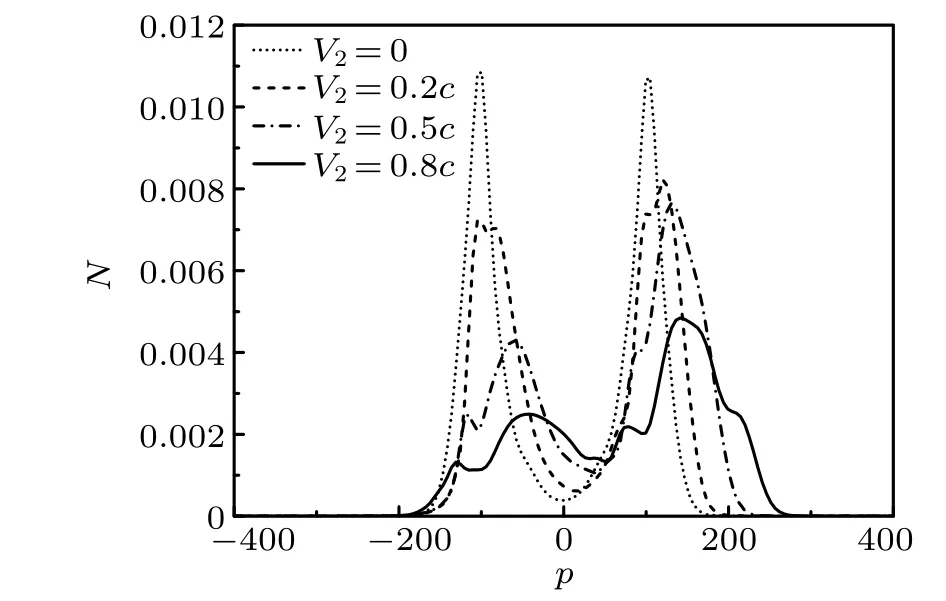
Fig.5.The momentum distribution of the created electrons under different static field intensities V2 at t=0.002. The amplitude and frequency of the oscillating field are V1=c2 and ω=2.5c2(the same as in Fig.1).
The momentum distributions give a clearer presentation of the velocities as well as the corresponding energies of the created particles. The simulated results of the created electrons for different intensities of the external static fields are presented in Fig.5. Here we still set the parameters asV1=c2andω=2.5c2. In Fig. 5, we use different lines to describe the momentum of the created particles under different external static field intensitiesV2=0, 0.2c2, 0.5c2and 0.8c2, respectively.


In addition,for an external oscillation field with narrower width,the energy of the created particles will be more concentrated. Therefore,for a static field with intensity stronger than the critical valueω-2c2,a higher proportion of created electrons can be dragged back and cause more annihilation effect,as pointed out in Fig.3.
5. Conclusions
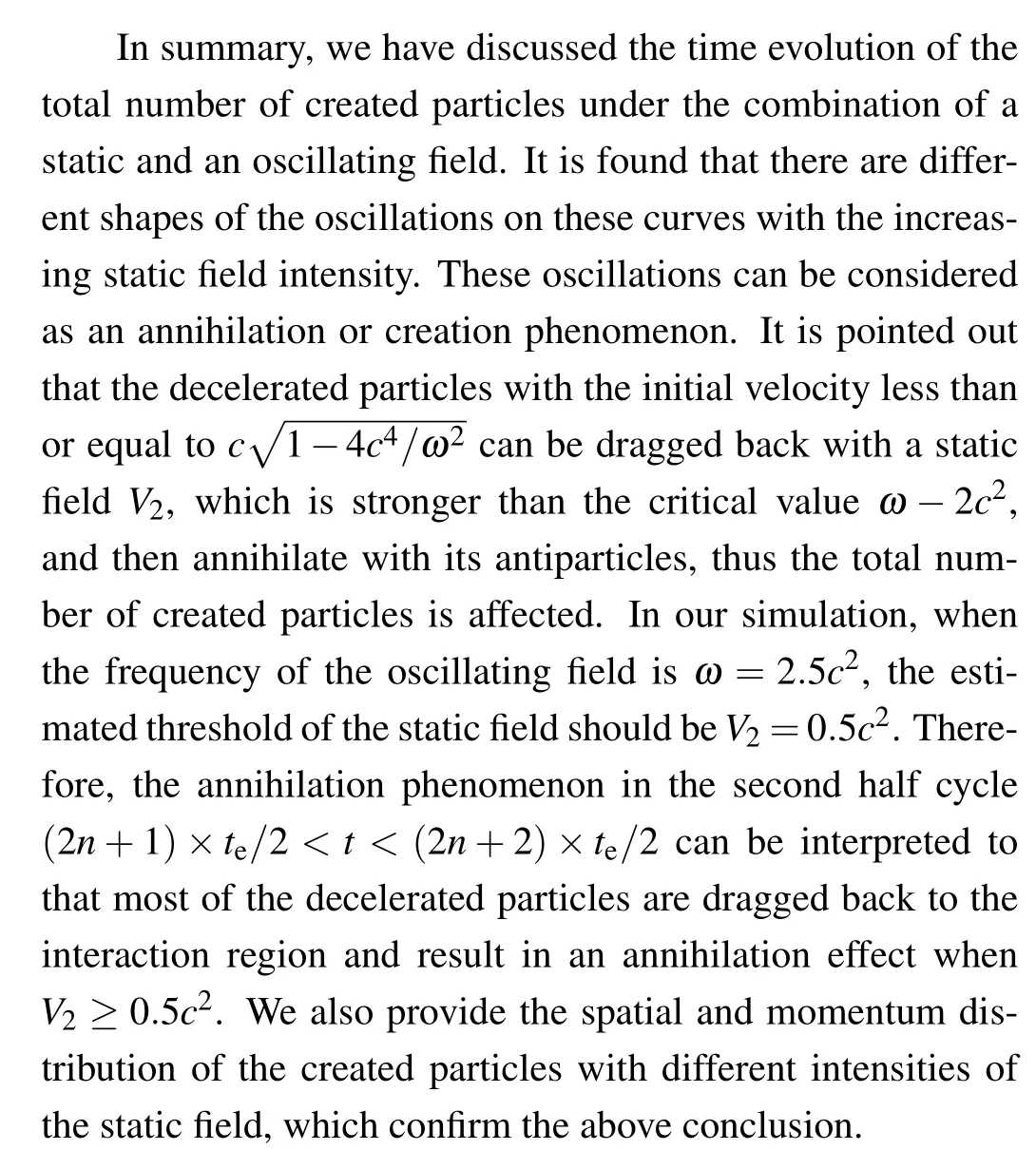
For an oscillating field with frequencyωthat is higher than the energy gap 2c2,the particles can be created continuously because of the single-photon transition effect. However,for a fermionic system, due to the Pauli blocking principle,the interaction region is filled with created particles and every state is occupied, the creation rate of the particles will be affected. By adding a static field,the created particles inside the interaction region can be evacuated and therefore increase the total number of created particles. However, for a static field with an intensity that is larger than the critical valueω-2c2as discussed in this paper,other than the particles that are accelerated and pushed out of the interaction region,a large proportion of created particles will be decelerated and dragged back into the interaction region, thus result in an annihilation effect which will cause the decrease of the total number of the created particles.
Although pair creation directly from the vacuum by light can not be achieved under the present experimental condition,many proposals have been raised regarding different combinations of the external electric fields. For a model with a high frequency oscillating field in a static field background,or two overlapping laser beams with substantially different frequencies when one field can be considered to be static, the results in this paper are applicable,and the annihilation effect must be considered.
- Chinese Physics B的其它文章
- Projective representation of D6 group in twisted bilayer graphene*
- Bilayer twisting as a mean to isolate connected flat bands in a kagome lattice through Wigner crystallization*
- Magnon bands in twisted bilayer honeycomb quantum magnets*
- Faraday rotations,ellipticity,and circular dichroism in magneto-optical spectrum of moir´e superlattices*
- Nonlocal advantage of quantum coherence and entanglement of two spins under intrinsic decoherence*
- Universal quantum control based on parametric modulation in superconducting circuits*

